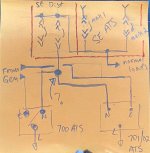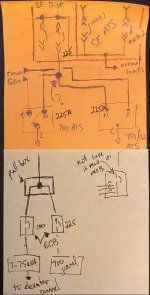CrapperEpiphanies
Member
- Location
- MD, USA
- Occupation
- EE
Looking at 2017 NEC: Reviewing a design where the normal, line side of a new Art 700 ATS is spliced into an existing Art 701/702 feeder that powers the normal, line side of Art 701/702 ATS. My initial reaction is that everything on the line and load side of the ATS should be strictly Art 700, and keep everything else separate to extent and exceptions allowed in Art 700.
But then reading 700.10(B), the section seems to address wiring separation "...from an emergency source or emergency source distribution overcurrent protection to emergency loads..." This feels like it's addressing the generator side and downstream of the ATS, and the handbook certainly has multiple graphical exhibits supporting this: generator output wireway feeding separate enclosures, or common bus but separate vertical sections, multiple generator feeders to separate enclosures, but I don't see any explicit verbiage or graphics addressing separation on the normal side of the ATS.
My question is what is meant by "emergency source" - do they mean the emergency line side of the ATS, OR any source to the ATS - normal and emergency?
Handbook commentary in 700.10(B) seems to support the general intent, but that's not enforceable since it's not code per se: "...wiring for emergency circuits must be completely independent of all other wiring and equipment. This practice ensure that a fault in any other system wiring [e.g. 701/702 ATS] will not affect the performance of the emergency wiring or equipment." Performance of Art 700 branch will definitely be affected if there's a fault on the 701/702 side that takes everything out, forcing the ATS to go on the alternate/emergency path.
Lastly - if you have a setup like this, can selective coordination even be accomplished per 700.32 through a splice? My understanding is that the entire purpose of selective coordination is to minimize unnecessary outage / interruption along the branch. In this case the entire non-emergency side can take out the emergency. So I feel like defining selective coordination as such gives me more of a leg to stand on than the verbiage in 700.10(B).
Thoughts?

But then reading 700.10(B), the section seems to address wiring separation "...from an emergency source or emergency source distribution overcurrent protection to emergency loads..." This feels like it's addressing the generator side and downstream of the ATS, and the handbook certainly has multiple graphical exhibits supporting this: generator output wireway feeding separate enclosures, or common bus but separate vertical sections, multiple generator feeders to separate enclosures, but I don't see any explicit verbiage or graphics addressing separation on the normal side of the ATS.
My question is what is meant by "emergency source" - do they mean the emergency line side of the ATS, OR any source to the ATS - normal and emergency?
Handbook commentary in 700.10(B) seems to support the general intent, but that's not enforceable since it's not code per se: "...wiring for emergency circuits must be completely independent of all other wiring and equipment. This practice ensure that a fault in any other system wiring [e.g. 701/702 ATS] will not affect the performance of the emergency wiring or equipment." Performance of Art 700 branch will definitely be affected if there's a fault on the 701/702 side that takes everything out, forcing the ATS to go on the alternate/emergency path.
Lastly - if you have a setup like this, can selective coordination even be accomplished per 700.32 through a splice? My understanding is that the entire purpose of selective coordination is to minimize unnecessary outage / interruption along the branch. In this case the entire non-emergency side can take out the emergency. So I feel like defining selective coordination as such gives me more of a leg to stand on than the verbiage in 700.10(B).
Thoughts?


